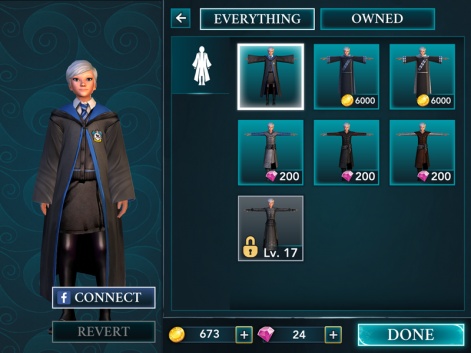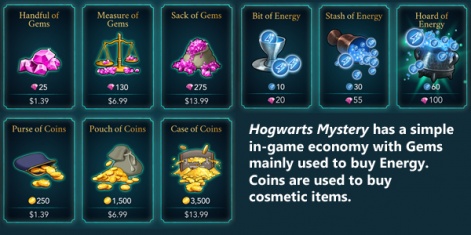Welcome to The In-App Purchase Inspector – our regular look at free-to-play mobile game monetisation from the consumer's perspective.
In each installment, we consider how well a developer has designed its in-app purchase retailing to work alongside the overall gameplay and metagame experience.
This week, we're looking at Jam City’s Harry Potter: Hogwarts Mystery.
All the right elements
Announced with much fanfare by US mobile game developer Jam City and Warners’ new Harry Potter studio Portkey Games in January 2018, Hogwarts Mystery is effectively a reboot for the whole Wizarding World franchise in terms of mobile gaming.
Set the period after Harry Potter’s birth but before he enters Hogwarts, the game is a high-quality production and plugs directly in the Hogwarts’ setting and Wizarding World lore, also featuring the likenesses and voices of key characters from the films including Albus Dumbledore, Severus Snape, Rubeus Hagrid and Minerva McGonagall.
Harry Potter: Hogwarts Mystery has been designed to appeal to a large number of people, only some of whom will spend a small amount of money.
As a game, Hogwarts Mystery is both narrative and task-based, with the player taking the role of a new student at Hogwarts, who as well as learning spells and potions, and building friendships, is also trying to solve the mystery of what happened to their brother, a student who was expelled from Hogwarts and subsequently has gone missing.
Energy gated
You progress through the game by completing missions, which are energy-gated in a similar manner to Kim Kardashian: Hollywood and The Sims Mobile.
You simply tap on highlighted items to complete tasks and each tap uses up one unit of energy. Once used up, your energy bar replenishes over time or you can instantly fill it by spending the game’s hard currency, Gems.
Other time-gated mechanics include waiting for new narrative missions to become available, or unlocking them immediately with gems.
These pinch points are clearly designed to be the game’s main retention and monetisation mechanics as the time you have to complete each mission is also time-gated. For example, you might have up to eight hours to complete a mission, a situation which would require you to return to the game multiple times.
Each mission is also star rated. Players need to earn a certain number of stars to complete the mission but can earn better rewards the more additional stars earned i.e. the more energy spent in the mission.
These rewards include in-game currency and XP, which is split into personal stats, Courage, Empathy and Knowledge. These are purely progression-based and can’t be purchased.
What to wear?
Aside from buying energy, Gems are also used buy specific items, such as the more exclusive clothes and accessories that make up the game’s character customisation feature.
These are not particularly high-value items, however, with the most expensive in the game’s early stages costing 400 gems, which is less than $15.

Hogwarts Mystery also uses a second in-game currency, Coins, which can also be purchased with real money and is used to purchase less valuable customisation items.
The game rewards you with both Coins and Gems for completing tasks, but is more generous in terms of Coins, which therefore act as the softer to these two hard currencies.
Wide appeal, shallow monetisation
Given the wide appeal of the Harry Potter IP, it’s no surprise Hogwarts Mystery has launched very well, being the most downloaded game in all key markets on the Apple App Store and Google Play store at the time of writing.
It’s also monetising well, being a top five grossing game in the likes of Australia, Canada, the UK and the US.
Yet, when considering the structure of its in-app economy, it’s clear the game’s continued success will be built on the back of continuing to generate a large number of downloads and retaining its audience through many months.
Clearly, Hogwarts Mystery is designed to be more like a Candy Crush Saga or Gardenscapes than a high revenue per player RPG game. Simply put, there just isn’t enough incentive for players to spend a lot of money.

You could spend hundreds of dollars in Harry Potter: Hogwarts Mystery if you want to instantly complete every mission, of course, but that’s not how the game is designed.
Instead, this pinch point is designed for players to occasionally use their Gems total to speed through a particular mission they want to complete rather than this being a way to play the game.
Similarly, while the customisation options are nice, they currently aren’t extensive enough to generate a lot of revenue. Nor does the Harry Potter IP provide the opportunity for the dynamic retailing of real-world items that proved lucrative in Kim Kardashian: Hollywood.
Hence, Harry Potter: Hogwarts Mystery has been sensibly designed to appeal to a very large number of people, only some of whom will spend a small amount of money. Keeping them playing for a long period of time will be Jam City’s challenge.






















